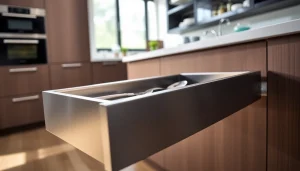Enhancing Space with Sliding Partition Walls: Benefits and Design Ideas

Understanding Sliding Partition Walls
What are Sliding Partition Walls?
Sliding partition walls are movable structures designed to divide spaces efficiently while offering flexibility in their use. These walls typically operate on tracks, allowing them to slide open or closed, creating multifunctional areas within a larger room without the need for permanent construction changes. Often made from a variety of materials, they can also be customized for aesthetics and functionality, making them suitable for both residential and commercial applications.
Benefits of Sliding Partition Walls for Different Spaces
Incorporating sliding partition walls provides numerous benefits across multiple environments. For residential spaces, these walls facilitate open-concept living while allowing for privacy when needed. In commercial settings, they promote versatility in office layouts, enabling quick transformations for meetings, presentations, and collaborative work.
Furthermore, sliding partition walls can enhance acoustic insulation, helping to minimize distractions in noisy environments. This combination of space efficiency and sound shielding makes them ideal for educational settings as well, where classrooms can be adapted for various group sizes and activities.
Key Features to Look for in Sliding Partition Wall Systems
When selecting sliding partition wall systems, several features should be evaluated to ensure they meet specific requirements:
- Material Durability: Choose walls made from durable materials like plywood, glass, or metal, which offer longevity and resistance to wear.
- Tracking Mechanism: Look for efficient track systems, which ensure smooth operation and stability when opening or closing the partition.
- Design Versatility: The aesthetic aspect is crucial; choose designs that complement the existing décor and can be customized for color and texture.
- Acoustic Performance: Effective soundproofing capabilities are essential for environments where noise reduction is important.
- Ease of Installation: Consider systems that are easy to install and require minimal maintenance, saving time and labor costs.
Types of Sliding Partition Walls
Materials Used in Sliding Partition Walls
Sliding partition walls can be constructed from various materials, each offering unique advantages:
- Wood: A classic choice, wooden partitions provide warmth, aesthetic appeal, and are highly customizable in design.
- Glass: Ideal for modern spaces, glass partition walls enhance natural light and maintain an open atmosphere while providing partial separation.
- Metal: Metal partitions offer a sleek, contemporary look and exceptional durability, suitable for high-traffic environments.
- Fabric: Soft partitions made from fabric can add a touch of comfort and can also help with sound absorption, making them suitable for offices and educational environments.
Different Designs and Styles Available
Sliding partition walls come in a plethora of designs and styles, catering to diverse aesthetic preferences and functional requirements:
- Panel Types: Ranging from full-height panels that touch the ceiling to lower, half-height options that allow visibility.
- Track Styles: Ceiling-mounted or floor-mounted tracks, offering flexibility based on the space’s specific needs.
- Finishes: Available in a wide array of finishes such as laminates, veneers, or paintable surfaces, which allow for customization.
- Configurations: Options for single or multiple panels that can stack or fold to accommodate various room dimensions.
Comparison of Fixed vs. Sliding Partition Walls
Understanding the differences between fixed and sliding partition walls is crucial for making an informed decision:
| Feature | Fixed Partition Walls | Sliding Partition Walls |
|---|---|---|
| Flexibility | Permanent and immovable | Movable, allows for reconfiguration |
| Installation Time | Longer, requires construction | Quicker, often pre-fabricated |
| Cost | Generally higher due to construction | Typically more economical for temporary needs |
| Design Options | Limited by structural elements | Wide variety of designs available |
| Sound Insulation | Often better acoustical performance | Varies by material; may include acoustic options |
Installation and Maintenance
How to Install a Sliding Partition Wall
Installing a sliding partition wall involves multiple steps:
- Planning: Measure the area to determine dimensions and select a design that fits the intended purpose.
- Gather Materials: Ensure all necessary materials, including the partition, tracks, fasteners, and tools, are ready for installation.
- Track Installation: Install the track on the ceiling or floor, ensuring it is level and securely anchored.
- Hang the Wall: Attach the sliding panels to the track by following the manufacturer’s instructions to ensure smooth operation.
- Final Adjustments: Check the alignment and functionality of the sliding doors, making necessary adjustments for optimal performance.
Maintenance Tips for Longevity
To ensure the longevity of sliding partition walls, consider the following maintenance tips:
- Regular Cleaning: Clean the tracks and panels regularly to prevent dirt buildup, ensuring smooth operation.
- Check Hardware: Periodically inspect the tracks, rollers, and fittings for wear and tear, replacing any damaged components promptly.
- Lubrication: Apply lubricant to moving parts to reduce friction and enhance functionality.
- Monitor Alignment: Ensure walls remain level and aligned after use, adjusting as necessary to prevent damage.
- Professional Check-ups: Consider hiring a professional to assess the system annually, especially for heavy-use environments.
Cost Considerations and Budgeting
The cost of sliding partition walls can vary significantly based on materials, design complexity, and installation requirements. Factors to consider when budgeting include:
- Material Choice: Custom glass options typically cost more than standard wooden panels.
- Size: Larger systems will naturally incur higher costs due to more material and installation time required.
- Track System: Advanced tracking mechanisms may increase initial expenses but enhance overall functionality.
- Installation Strategy: DIY installations save money but may require expert assistance to ensure proper functionality, particularly for larger or more complex installations.
Real-Life Applications of Sliding Partition Walls
Residential Spaces: Creating Versatile Living Areas
In homes, sliding partition walls can redefine how spaces are utilized. For example, homeowners can create a playroom for children where the walls can be pushed aside when entertaining guests. This versatility fosters an environment that balances openness with privacy.
Commercial Use in Offices and Studios
In office designs, sliding partition walls are instrumental in facilitating collaborative workspaces. They allow the transformation of open areas into conference rooms or quiet zones and can adapt to changing business needs over time. Additionally, creative studios frequently utilize sliding walls to separate workstations while maintaining a cohesive atmosphere.
Educational Settings: Enhancing Classroom Dynamic
In educational facilities, sliding partition walls can convert larger spaces into smaller classrooms, accommodating evolving class sizes or team-based learning scenarios. This adaptability not only maximizes the use of space but also fosters collaboration among students.
Designing with Sliding Partition Walls
Optimal Layouts for Home Interiors
Designing with sliding partition walls requires strategic planning of layouts to ensure functionality and aesthetics. Optimal layouts consider:
- Traffic Flow: Ensure the movement between spaces remains uninterrupted, avoiding chaos during transitions.
- Zoning: Utilize sliding walls to create distinct areas for dining, leisure, and work while maintaining an open feel.
- Light Considerations: Fix walls or choose materials that allow natural light to flow through, enhancing energy efficiency and ambiance.
Incorporating Color and Texture in Design
When designing spaces with sliding partition walls, consider not just functionality but also how color and texture can enhance the environment:
- Color Schemes: Opt for colors that align with the room’s purpose; calming tones for relaxation areas or vibrant hues for creative spaces.
- Textured Finishes: Incorporate wood finishes or fabric to soften the appearance and create a more inviting atmosphere.
- Artistic Touches: Custom prints or designs on sliding walls can serve as focal points within a room.
Case Studies: Successful Implementations of Sliding Partition Walls
To illustrate the impact of sliding partition walls, consider the following case studies:
- Urban Apartment Transformation: A 800 square-foot apartment in New York utilized sliding walls to create a temporary guest bedroom, enhancing the living area’s functionality without sacrificing space.
- Corporate Office Redesign: A leading tech company’s office employed modular sliding walls to quickly adjust workspace layouts according to project needs, significantly increasing productivity and employee morale.
- School Multipurpose Room: An elementary school installed sliding partition walls in a converted gymnasium, allowing the space to serve various functions from classrooms to auditoriums, promoting active learning.







